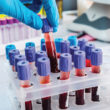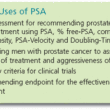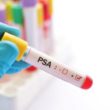PSA Velocity: Important New Tool in Fight Against Prostate Cancer
One of the big but unanswered questions about prostate cancers is: Which ones are aggressive and which ones are not?
In a recent study, my research partners and I have found some answers that very likely will change the way prostate cancer is diagnosed and then treated.

We have found that the rate of rise in the Prostate-Specific Antigen (PSA) level, which is called the PSA Velocity, prior to diagnosis of prostate cancer (CaP) is a more powerful indicator of eventual recovery or death from prostate cancer than the actual PSA level itself.
Our study, (Anthony V. D’Amico, M.D., Ph.D., Min-Hui Chen, Ph.D., Kimberly A. Roehl, M.P.H., and William J. Catalona, M.D.) was published in the July 2004 issue of the New England Journal of Medicine and has been reported in major media outlets across the United States.
The study results indicate that men with a high PSA velocity should not be managed by watchful waiting, which could be especially harmful if the cancer is fast-growing.
Our study suggests that a rapid rise in the PSA score is a sign the cancer is particularly aggressive, and some men with CaP and a high PSA Velocity will require more than a radical prostatectomy to prevent prostate cancer death.
“PSA Velocity will likely change the way CaP is diagnosed and treated.”
The results also imply that PSA velocity measurements during the year before the diagnosis of prostate cancer can help identify the potential aggressiveness of the cancers. Those with a .75 PSA increase within a year show a worrisome risk for prostate cancer. Those with a 2.0 increase within a year are more likely to have an aggressive cancer with a higher potential risk for death.
We also found that if the PSA level had been increasing slowly before surgery, then treatments are most effective and patients have little chance of dying from the cancer.
Our study found that when PSA levels rose by at least 2 points during the year before surgery, about one in six of those patients had died from prostate cancer within seven years.
Although the relative risk of death from prostate cancer was nearly 10 times greater in the higher PSA velocity group, other variables were important as well. PSA can also rise because of BPH or prostatitis, so when the PSA does begin to rise, men should be treated with antibiotics to see if the PSA will return to normal before proceeding to biopsy.
“I recommend having a baseline PSA at 40.”
The lifetime risk of being diagnosed with prostate cancer 1 in 6 is higher than the 1 in 8 risk of breast cancer in women. It is a big problem and it kills a lot of men.
While some physicians counsel watchful waiting, the men I see in my office have the same attitude as women facing the possibility of breast cancer: they want it treated; they want it taken care of; and they want it to be over.
Previously, I had been recommending a biopsy with a PSA level of 2.6 or higher, and I will continue this recommendation. However, it will be tempered by the findings of our study that shows us no single value of PSA is as important as the PSA Velocity.
I recommend having a baseline PSA at 40. The nice thing about starting at age 40 is most men at that age have a PSA that is somewhere around 0.6. If the next annual PSA test shows a PSA of 1.4, those men should not wait until the next year to get checked again even though it looks as if the PSA (less than 2.6) is not high enough to warrant a biopsy. Instead, they should get checked again within three months.
My new recommendation is to test early for a baseline PSA and test every year thereafter to recognize a rapidly rising PSA.




















